
I’m just back from New York, and am off to Portland tomorrow, where I’ll be when this article drops.
(Yes, I have a headache.)
I’ve been traveling a lot lately, and there’s plenty more to come, so today it’s time to tell you what I observed, as a journalist, in New York and New Jersey earlier this month.
It’s important to date it, because in 2019, these places I know so well have finally stood up tall and joined the 21st Century.
Proudly.
They’ve developed, or grown, in ways that feel authentic, and at times exciting. (As someone who grew up and lived there.) It’s a funny word to use, development, because among a certain political class, it’s almost always seen as a bad thing.
Gentrification –> Development = Low-income residents getting pushed out.
That’s normally the equation, and I get it. (My MFA thesis project in 2004 was about corn fields in my suburban hometown getting turned into McMansions.)
Sure, it was a Dutch farming village for 300 years before my parents got there, but I didn’t want those farms to become more suburbs.
No more people like me moving in to spoil it!
I gentrified the Southern end of the Mission District in San Francisco in 1999, and then Greenpoint, Brooklyn in 2002, and left both places as they were getting too trendy.
Hell, Jessie and I moved back to Taos in 2005 expecting hordes of Gen Xers to follow us, but instead it’s been the Millennials who’ve gotten in on the action in the last three or four years.
All of which is to say, I’ve been a gentrifier, and one who took pains at each new farm that was plowed under for another house like my own.
In general, over the course of my life, I’d say I tended towards the condemnation of massive real estate developments, and appreciated when things stayed the same, as they did in San Francisco for 10 years after I left.
But now, the San Francisco skyline has been ruined by Salesforce, the local culture is supposedly all about tech bros, and I’d have to think hard about how many people I know who live in the city these days, rather than in the surrounding area.
New York City, though, is something different. (As is New Jersey, which we’ll get to in Part 2.)
Yes, it’s my home turf, and I’m biased. I’ve written before that I grew up able to see the Twin Towers from my hometown, gleaming across the bay.
I took it personally when the towers were destroyed in 2001, but I think something of New York’s soul was taken too. Not that it’s people were cowed, because that will never happen.
(Not in my lifetime, anyway.)

Rather, the skyline was ruptured so badly, and then the local politicking, which is always dirty in New York, kept the Freedom tower from getting built FOREVER.
Really, you can look it up.
When did the Freedom Tower open to the public?
(Rare Google break…)
OK. I’m back. 2014.
That’s when the first tenant moved in.
It took New York City 13 years to replace it’s iconic Southern anchor to the skyline.
And even then, the building is just OK.
In the interim, there was a phase where some very average looking, minimalistic residential super-towers were built, which made the city lean wrong, and all that visual weight went towards the super-rich, with their part time crash pads. (I accidentally wrote cash pads, which is a good Freudian slip.)

Nowadays, in 2019, finally, I’m thrilled to report that New York City has grown in exciting and beautiful ways. (Revitalizing growth that sometimes gets a bad rap, I think.)
In my experience, New York City has become a global tourism Mecca. In the sense that, like Paris, it now belongs to everyone.
And sometimes that comes at the expense of the locals.
Certainly, Manhattan, Brooklyn and now probably Queens are not affordable for “regular” people. Not unless you live “all-the-fuck-out-there” by the ocean.
And even where I’m from, in New Jersey, or in other outlying areas like Long Island or Westchester, the cost of living is high across the board. (Food, rent/home prices, transportation…)
Manhattan just adopted congestion pricing for the first time, to charge people for driving in the heart of the city, and the cost of tolls at bridges is nearly $20 as is.
In particular, though, I’d like to discuss Hudson Yards, the new mega-development by Stephen Ross, which recently opened in what used to be called Hell’s Kitchen on Manhattan’s in Midtown’s Far West Side.

It was supposedly built on a $1 Billion platform over a railyard, and I’ve seen that tactic used in public parks in Chicago and Dallas to good effect. (In Dallas it was over highway, but still…)
Hudson Yards has gotten panned, from what I’ve heard, because it really was built for rich people, and tourists. (I guess I’m kind of the latter, these days.)


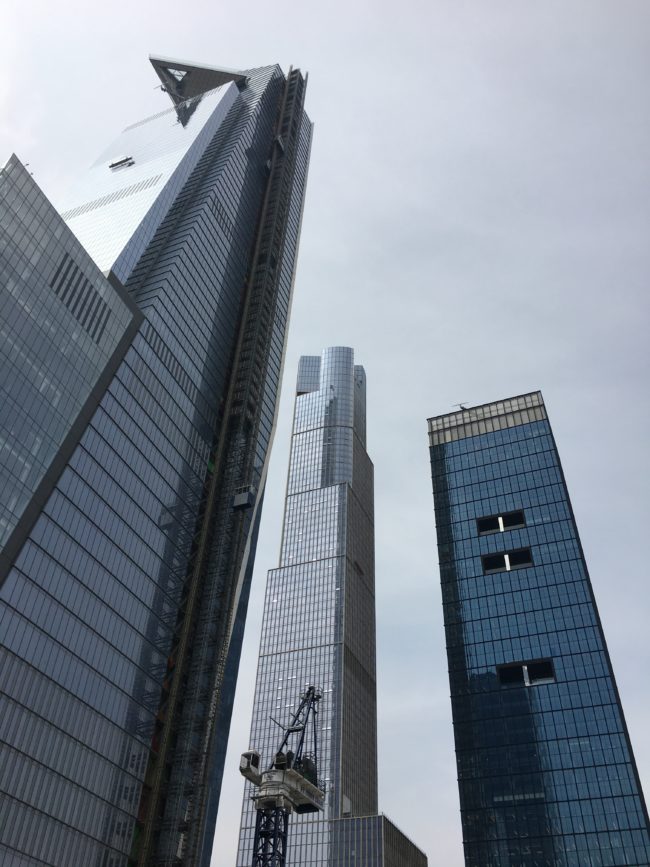
There are something like six new blue-glass skyscrapers by Starchitects, and they surround a big public courtyard with the the Shed, a public art space, and the massively expensive “Vessel,” a glowing bronze public art project for which you have to get a free ticket.
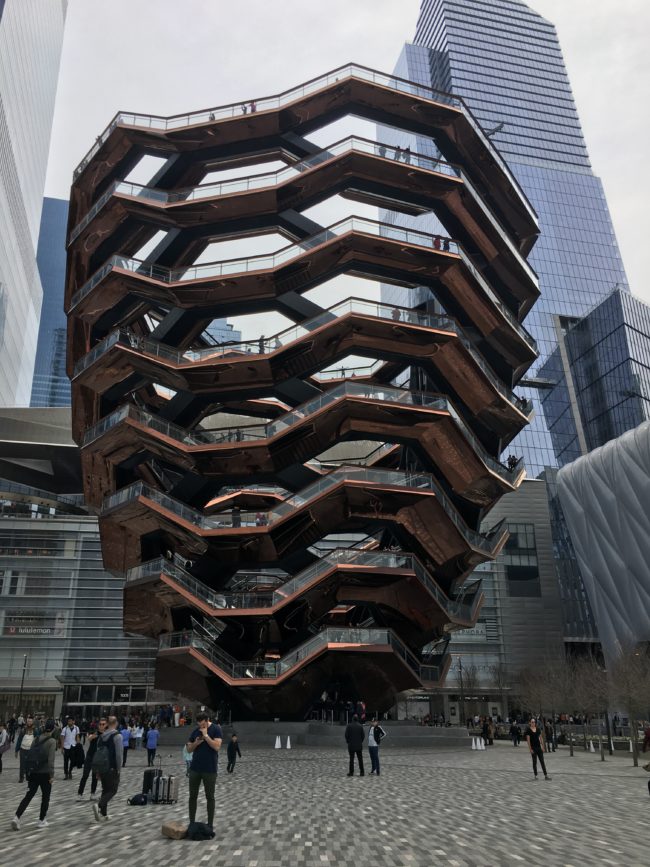
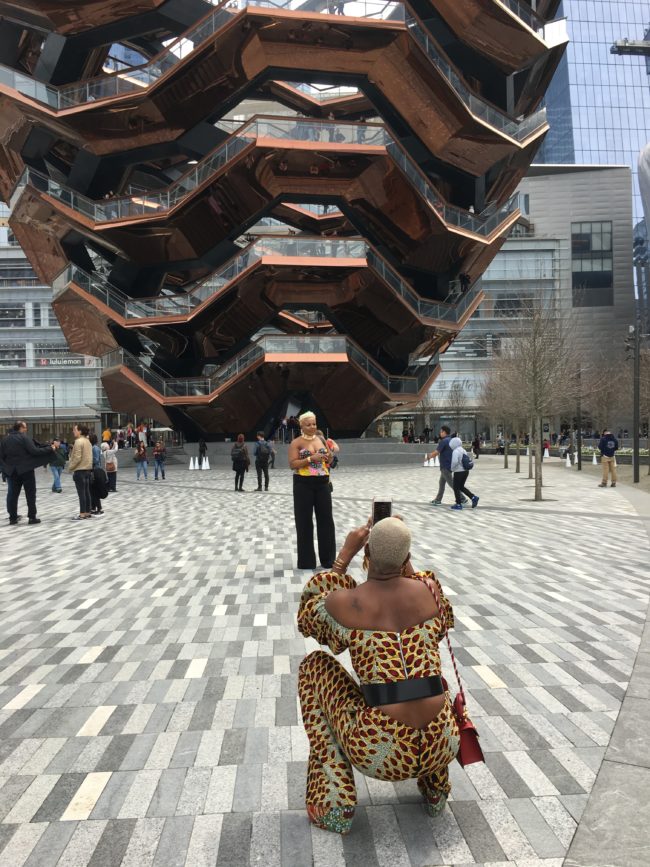
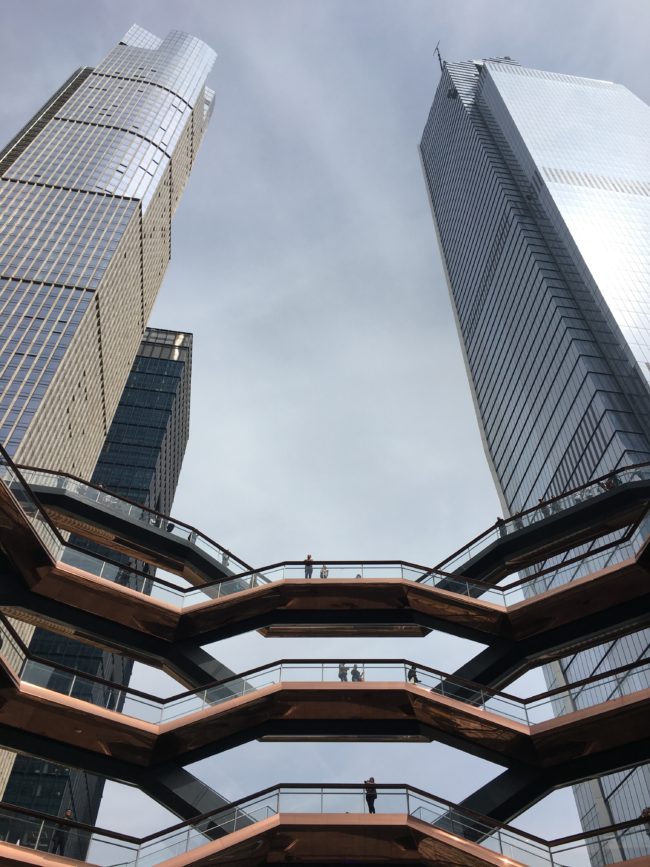
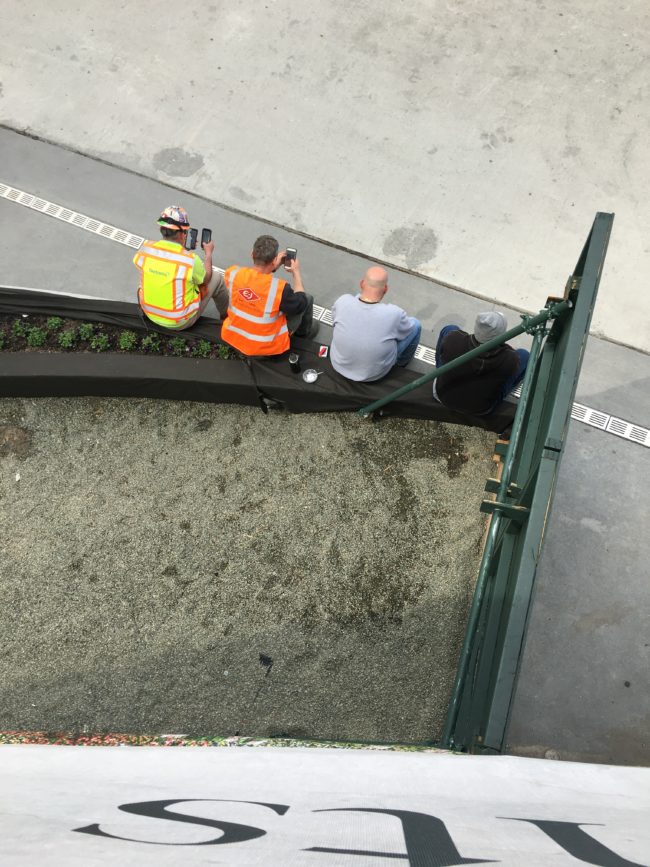
It is literally a stairway that goes nowhere, built to be an Instagram backdrop, and it does that job well. I was little confused by the physical placement within the city skyline, if it’s meant to be iconic, but then I noticed this ad in The New Yorker, which about sums up the demographic.
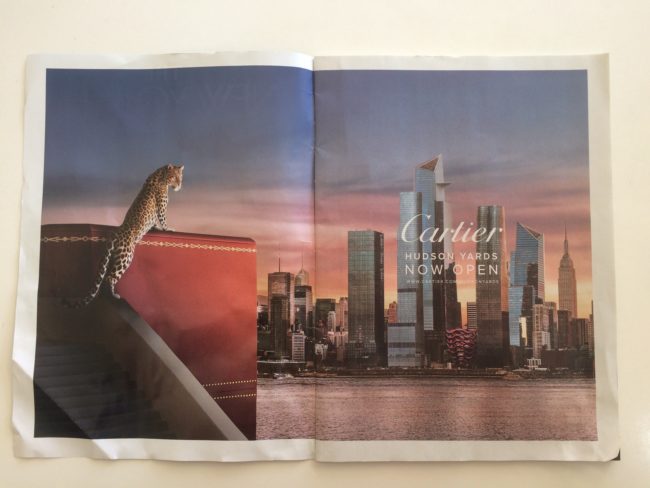
On the lower levels of one of the buildings is a huge shopping mall and food court featuring very expensive and/or trendy brands. (Muji is not fancy, but it is cool.)
I understand my point may be somewhat controversial, but I’ve been to that part of town, over the years, and it was a bit of a wasteland.
I can also attest, at 45, that New York has always been about money.
It’s the heart of Capitalism, for crying out loud.
So as a former resident, and now regular visitor, I accept that it was always going to become too expensive for people like me to actually live there.
Hell, I don’t want to live there.
The air quality and weather suck, and it’s too busy for every day.
But seeing such beautiful, gleaming buildings in Hudson Yards, it inspired me.
They’re gorgeous.
And everywhere you look, including in odd places like the Lower East Side, there are new-looking skyscrapers that balance the Empire State and Chrysler buildings, and support the Freedom Tower, which was never meant to carry downtown alone.
(Brooklyn has tons of new hi-rise buildings too, so many that when my father-in-law last visited in 2004, there were none, he confirmed.)
Sticking with Manhattan, though, Hudson Yards blends right into the northern end of the High Line through Chelsea, which is itself a phenomenal piece of design and public space.
Whereas in the past, right at the junction between the two, there might have been a locally owned pizza place, now, it’s a restaurant by Jose Andres and the Adria Brothers. That’s a massive change, and I can see how some people might hate it. (I still miss the ubiquity of a great slice.)
Between the architecture that’s grown around the High Line, like the Zaha Hadid masterpiece, to the nature planted within it, the High Line is always popular, and rightly so.
(We went twice, and each time it was wall-to-wall people, speaking countless languages.)
The High Line ends in the new Whitney, which conveniently flows into Hudson River park, which goes south along the waterfront along the city.

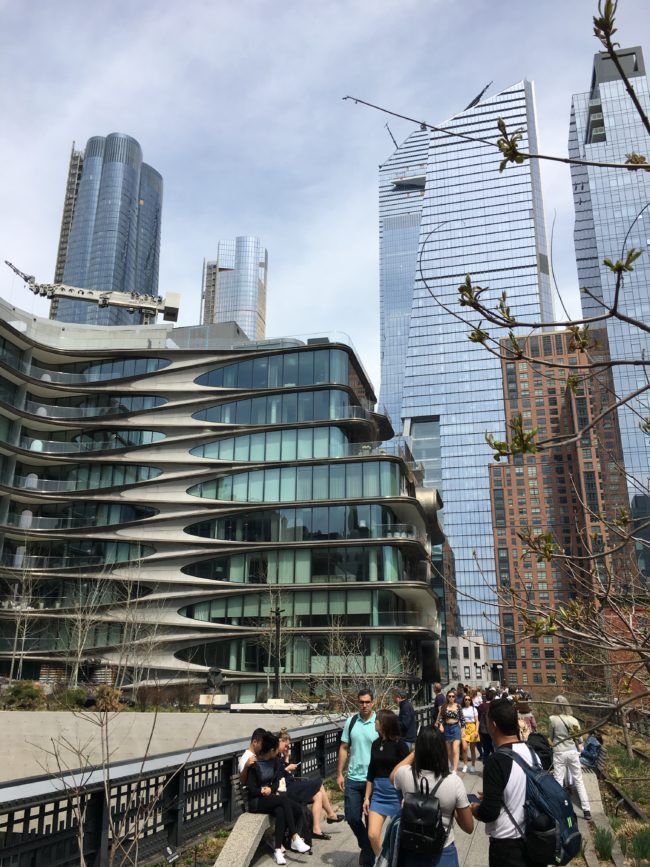
It’s fantastic, frankly.
And none of it was there when I moved back to town in 2002.
I haven’t mentioned Hurricane Sandy, yet, which hit in 2012, but that was a real punch in the nose for the Tri-State Area.
Given that New York is a money town, between 9/11, the following market crash, the 2008 crash, and then Sandy, the city was properly down on its knees.
Maybe not like the big bad 70s, but New York looked stale, visually, and I’d argue maybe it was.
As cities like Shanghai and Dubai raced towards the future, New York seemed stuck in the past.
But no longer.

These days, I think it’s pretty badass that New York has opened itself proudly to the world.
It’s thriving, and looks pretty great too. (Except for the garbage on the streets, because New York is always gonna New York.)
There’s so much more to tell, (including a few anecdotes about AIPAD,) but we’re nearing 1500 words, and I’ve got photos this time!
There’s no need to over-do it, so I’ll run it back with Part 2 next week.
Have a good one.
4 Comments
Forget who said it a coupla decades ago… “Artists, the shock troops of gentrification!”
I suppose that’s morphed into techies… at least the former were somewhat rooted in reality:
way too many of the latter only care about what enters their lives through their modem…
I know you keep calling it Freedom Tower but it’s really called One World Trade Center.
I’m also a past resident of NYC (lived there for 12 years, right after September 11) and I remember reading in the NYTimes about the High Line plans, and few years later, seeing it come to life. And now, with the Hudson Yards (regardless it is mostly for over-rich people) it shows how NYC is re-inventing itself and creates new neighborhoods out of nothing.
I keep visiting my ‘used to be my home city’ almost every year, and each time there is something new.
A few years ago I took a photography class at ICP and we toured the old warehouses of Williamsburg. Now they are gone and replaced by glitzy boutique hotels. These are beautiful hotels, but something in the magic of old Brooklyn is forever gone.
I’m even more pumped for my visit to NYC, from Australia next month. Two questions remain, colour or black and white, Rollieflex or Hasselblad?
Comments are closed for this article!